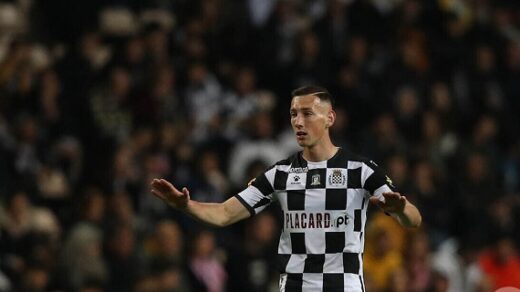The Tactical Trial 4-2-3-1 Formation, which we will examine, which is frequently used in many leagues, especially in Turkey, is with you…
What is 4-2-3-1?
The 4-2-3-1 formation works on four lines. On defense, there is a back four with two central defenders and two full backs. Two deep midfielders serve in front of the back line and are often referred to as double pivots. Further ahead, an attacking midfield trio plays behind a lone striker.
Where does 4-2-3-1 come from?
With many teams using a retracted striker in the late 1990s 4-4-2, 4-2-3-1 was introduced in the late 2000s to prevent access to the central spaces between the lines. This was due to initially having a single pivot covering these gaps before a second defensive midfielder was added in front of the backline – Claude Makélélé being the most notable of these.
This line-up became more popular as the press became a bigger part of the modern game. The double pivot takes up space in front of the back four but also supports the pressure behind the center forward and attacking midfield trio. Manchester City assistant manager Juanma Lillo is thought to have instigated the transition from 4-4-2 to 4-2-3-1 in Spanish football, and high press is a major contributing factor.
How to play 4-2-3-1?
Between 2008 and 2012, Spain dominated world football by fine-tuning the 4-2-3-1 system and spearheaded the rise of this line-up into the mainstream. In fact, their success with this team (they won 2 European Championships and 1 World Cup during this period) has led them to become probably the most popular line-up in the world for several years. However, this iconic international side was not the first team to use 4-2-3-1 (despite coming from Spain).
Spanish coach Juanma Lillo, who currently works as an assistant to Pep Guardiola at Manchester City, is considered the first defender of this system. A largely unknown but still revolutionary manager, Lillo made a huge early impact on Guardiola when he took over the first La Liga club, Salamanca, in 1992 at the age of 29. He started defending 4-2-3 here.
Having 5 midfielders makes this possible; however, configuring them as 2 separate units allows the central defensive midfielders to concentrate on protecting the back four and advancing the ball, while the 3-row forward focuses on supporting the forward and creating chances.
These 3 midfielders can also be extremely fluid, swapping positions with each other and immersing themselves in advanced areas to connect with the striker. This is very important, because otherwise the lone striker may be left alone. Regardless, the defenders will be relied upon to put pressure on them and prevent them from easily carrying the ball forward.

What are the strengths of the 4-2-3-1 formation?
One of the most important reasons why the 4-2-3-1 formation has come to the fore in the last 15 years is the sense of balance it provides. The combination of a back four and two midfielders gives the teams strong defensive stability.
Even if the guards decide to step forward and join the attack (as did Dani Alves and Marcelo in Brazil’s 4-2-3-1 formation), there are still two midfielders (also called double pivots). the defensive bodyguard and the two defenders sat even deeper behind them. Pushing these two fullbacks forward can also force opposing wingers to step back and protect them, as well as create plenty of room in more advanced positions.
Perhaps the most important benefit of playing 4-2-3-1 is that it gives your team a chance to hold the ball and stay in possession for a long time. If your goal is to use your four-back to pick up the ball from the goalie and push it forward, the two central defensive midfielders make great exits and can seamlessly connect defense and offense. Once in possession of the ball, all 5 midfielders can spread wide, create overloads in the midfield and dominate the ball using complex passing triangles.
But don’t think that 4-2-3-1 is all about sitting happily, taking a moment to pass the ball through the midfield and defensive areas, and attacking patiently. It can also be a pretty aggressive formation. Having 2 central midfielders who always provide cover allows the 3 more advanced midfielders to put high pressure and actually become forwards themselves, creating a front 4 that can cause chaos in the opposing defenses.
Chances are created by hitting the ball high, gaining dominance, and connecting together as a fluid front 4. Sounds good, right? When implemented properly, stopping 4-2-3-1 can be incredibly difficult. However, there are some weaknesses that this shape brings. Let’s look at them.
What are the weaknesses of the 4-2-3-1 formation?
Like most advanced formations, 4-2-3-1 requires constant communication and hard work. To remain tidy and organized, each part of the formation must always instruct and advise each other. This is especially important for the 2 midfielders (or CDMs) who need to remain disciplined and defensively focused while also always giving pass options to the person in possession of the ball.
It may also be more effective for some central defensive midfielders to sit by themselves and play the ‘destroyer’ role; For example, consider Chelsea’s Claude Makelele or Manchester City’s Fernandinho. Using 4-2-3-1 can make your central midfield area a little tight or tight. However, that doesn’t have to be the case, and if strong communication is maintained throughout matches, it’s unlikely to be a big deal.
Another thing worth mentioning is the large midfielders. If your two wider midfielders aren’t quick and dominant in one-on-one situations, they can tend to be weak links. Not only do they need to be able to connect with the forward to create chances, they also need to be able to hit the ball hard, limit the options of opposing defenders and follow back if the ball passes them. A lot of creative responsibility has been placed on CAM (central offensive midfielder) who will often be the star player of a team (think Mezut Özil, David Silva or Thomas Müller).
It’s easy to see why 4-2-3-1 replaced 4-4-2 as Europe’s dominant formation in the late 2000s – mainly because their weakness is much less effective. Playing with 2 forwards can create any risk that is eliminated by the 4-2-3-1 system; 3 advanced midfielders can lead the attacks while simultaneously dominating the central ball. So who benefited from this important football development? Time to discover the most famous clubs and managers who have used the 4-2-3-1 system.
Which clubs and coaches use the 4-2-3-1 system?
The 2010 World Cup highlighted the dominance of the 4-2-3-1 system; all four semi-finalists are using double pivots and Spain, Germany, and the Netherlands are 4-2-3-1 (whereas Uruguay wanted more of a 4-4-2 with 2 deep-mids). Vincent Del Bosque’s World Cup-winning Spanish team were arguably the most important pioneer of the 4-2-3-1 system. The double pivot of Sergio Busquets and Xabi Alonso has proven to be one of the best CDM partnerships in world football.
Other successful implementations of 4-2-3-1 include Bayern Munich, which has used this system to completely dominate the Bundesliga over the past decade. Coaches like Hansi Flick and Julian Naglesmann have adapted the shape in different ways. But the success of the German champions rested on the basic foundations of the 4-2-3-1 structure.
Click here for my other analysis on football.




4-2-3-1 is good mostly for defensive approach teams but still needs two very good right and left backs to blend well